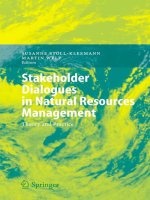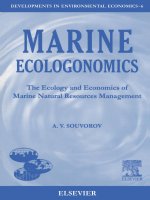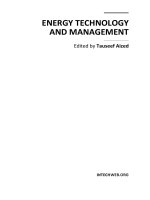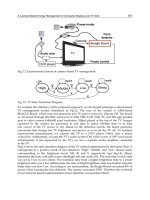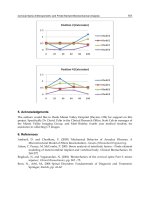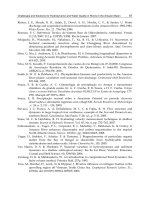Sustainable Natural Resources Management Part 9 pot
Bạn đang xem bản rút gọn của tài liệu. Xem và tải ngay bản đầy đủ của tài liệu tại đây (479.87 KB, 14 trang )
Sustainable Use of Natural Resources of
Dryland Regions in Controlling of Environmental Degradation and Desertification
101
MacDicken, K. G. & N. T. Vergara, editors. 1990. Agroforestry: Classification and Management.
John Wiley & Sons, Inc. , ISBN 0-471-83781-4, New York, New York, USA.
Mainguet, M. 1999. Aridity: Droughts and Human Development. Springer-Verlag. ISBN 978-3-
540-63342-6, New York, New York, USA.
Marples, S. 1986. Production and Investment in Marginal Areas. In Development of Rainfed
Agriculture Under Arid and Semiarid Conditions, Davis, T. J. , editor, p. 87, The World
Bank, ISBN 0-821-30817-2, Washington, DC, USA.
McNeely, J. A. , K. R. Miller, W. Reid, R. Mittermeier & T. B. Werner. 1990. Conserving the
World's Biological Diversity. The World Resources Institute, The World Wildlife
Fund, and The World Bank, ISBN 0-915825-42-2, Washington DC, USA.
Middleton, N. & D. Thomas, editors. 1997. World Atlas of Desertification. United Nations
Environment Programme and A. Holden Arnold Publications, ISBN 0-340-69166-3,
London, England.
Mouat, D. A. & C. F. Hutchinson. 1995. Desertification in Developed Countries. Kluwer
Academic Publishers, ISBN 0-7923-3919-3, AH Dordrecht, The Netherlands.
Mukhoti, B. 1986. Forestry Projects and Landless Farmers - A View of Issues from Within a
Donor Agency. Bulletin of the Culture and Agriculture Group 30:7-12.
Nair, P. K. R. , editor. 1989. Agroforestry Systems in the Tropics. Kluwer Academic Publishers,
ISBN 90-247-3790-7, AH Dordrecht, The Netherlands.
Okigbo, B. N. 1991. Development of Sustainable Agricultural Production Systems in Africa.
International Institute of Tropical Agriculture, Ibadan, Nigeria.
Postel, S. 1997. Last Oasis: Facing Water Scarcity. W. W. Norton Company, ISBN 0-393-31744-
2, New York, New York, USA.
Pratt, D. J. & M. D. Gwynne, editors. 1977. Rangeland Management and Ecology in East Africa.
Robert E. Krieger Publishing Company, ISBN 0-88275-525-0, Huntington, New
York, USA.
Raintree, J. B. , editor. 1887. Land, Trees and Tenure, University of Wisconsin, Land Tenure
Center, ISBN 0-934519-01-3, Madison, Wisconsin, USA.
Repetto, R. 1988. The Forest for the Trees: Government Policies and the Misuse of Forest Resources.
: World Resources Institute, ISBN 978-0-915-82528-7, Washington, DC, USA.
Salem, B. B. 1988. A Strategy on the Role of Forestry in Combating Desertification. In Arid
Lands: Today and Tomorrow, Whitehead, E. E. , C. F. Hutchinson, B. N. Timmermann
& R. G. Varady, editors, pp. 841-869, Westview Press, ISBN 0-8133-7536-3, Boulder,
Colorado, USA.
Schechter, J. 1988. Obstacles to the Transfer of Agricultural Technology Due to Inadequate
Farming Systems in Developing Countries. In Arid Lands: Today and Tomorrow,
Whitehead, E. E. , C. F. Hutchinson, B. N. Timmermann & R. G. Varady, editors,
pp. 1255-1267, ISBN 0–8133-7536-3, Westview Press, Boulder, Colorado, USA.
Seckler, editor. 1993. Agricultural Transformation in Africa. Winrock International Institute for
Agricultural Development, ISBN 0-933595-77-8, Arlington, Virginia, USA.
Sharma, N. P. , editor. 1992. Managing the World's Forests. Kendall Hunt Publishing
Company, ISBN 0-8403-7885-8, Dubuque, Iowa, USA.
Spedding, C. R. W. 1988. An Introduction to Agricultural Systems. Elsevier Applied Science,
ISBN 1-85166-191-3, New York, New York, USA.
Sustainable Natural Resources Management
102
Squires, V. R. & A. E. Sidahmed, editors, 1998. Drylands: Sustainable Use of Rangelands into the
Twenty-First Century. International Fund for Agricultural Development, ISBN 92-
9072-006-9,Rome, Italy.
The World Bank. 1993. Water Resources Management. The World Bank, ISBN 0-8213-2636-8,
Washington, DC, USA.
The World Bank. 2003. Land Policies for Growth and Poverty Reduction. The World Bank, ISBN
0-8213-5071-4, Washington, DC, USA.
The World Bank. 2005. Agriculture Investment Sourcebook. The World Bank, ISBN 0-8213-
6085-X, Washington, DC, USA.
Thomas, R. , M. Colby, R. English, W. John, B. Rassas & P. Reiss. 1993. Water Resources Policy
and Planning: Toward Environmental Sustainability. U. S. Agency for
InternationalDevelopment, Irrigation Support Project for Asia and the Near East,
Washington, DC, USA.
Tunstall, D. , N. Henninger & R. P. White. 2002. An Ecosystem Approach to Drylands: Building
Support for New Development Policies. World Resources Institute, ISBN 1-56973-499-2,
Washington, DC, USA.
United Nations Environment Programme. 1992. World Atlas of Desertification. Edward
Arnold, ISBN 0-3405-5512-2, London, England.
Walker, B. H. , editor. 1979. Management of Semi-Arid Ecosystems. Elsevier Scientific
Publishing Company, ISBN 0-444-41759-1, AH Dordrecht, The Netherlands.
Weber, F. R. 1989. Policy Relating Arid-Zone Forestry to Rural Development and
Desertification Control. In The Role of Forestry in Combating Desertification, Food and
Agriculture Organization of the United Nations, editor, pp. 82-90, Food and
Agriculture Organization of the UnitedNations, Conservation Guide 21, ISBN 92-5-
102806-8, Rome, Italy.
White, T. A. 1993. Development of Rural Haiti: Policy Lessons from Natural Resources Projects.
EPAT/MUCIA/USAID Draft Working Paper, University of Minnesota, St. Paul,
Minnesota, USA.
White, T. A. & H. M. Gregersen. 1993. Priorities for Programs in Rural Haiti: Policy Lessons from
Natural Resources Projects. EPAT/MUCIA/USAID Draft Policy Brief, University of
Minnesota, St. Paul, Minnesota, USA.
Whitehead, E. E. , C. F. Hutchinson, B. N. Timmermann & R. G. Varady, editors. 1988. In
Arid Lands: Today and Tomorrow, Westview Press, ISBN 0-8133-7536-3, Boulder,
Colorado, USA.
Wiersum, K. F. 1988. Outline of the Agroforestry Concept. In Wiersum, K. K. , editor.
Viewpoints on Agroforestry, pp. 1-26, Agricultural University Wageningen,
Wageningen, The Netherlands.
World Resources Institute. 1992. World Resources 1992-93. Oxford University Press, ISBN 0-
19-506230-2, New York, New York, USA.
Part 3
Natural Resources
Management and Poverty Alleviation
5
Sustainable Natural Resource Management,
a Global Challenge of This Century
Esmail Karamidehkordi
Agricultural Extension and Education Department,
Faculty of Agriculture, Zanjan University, Zanjan,
Iran
1. Introduction
Food security, environment management and poverty alleviation are main factors contributing
the complexity of natural resource management. This chapter intends to show the scope of
these challenges in the worldwide and to propose some strategies for managing these
challenges or complexities. In definition, food security exists when all people, at all times, have
access to sufficient, safe and nutritious food to meet their dietary needs and food preferences
for an active and healthy life (FAO, 2011a). The world must feed 9.8 billions people by 2050.
The challenge of food security is not a new story, but it is still one of the main crises of the
world. The food crisis and famine in the Horn of Africa, especially Somalia, has just happened
in 2011. Millions of people in Africa and Asia are under threat of famine. This may not be
because of only food shortage, but due to lack of capability of some areas to provide food to
their people. The President of the International Fund for Agricultural Development (IFAD) in
the World Food Day 2011 pointed out that "As long as there is even one person dying of
hunger we must do everything within our power to prevent it. The latest crisis in the Horn of
Africa shows the terrible human cost of neglect, both of agriculture and rural areas. Droughts
are not preventable but famines are” (FAO, 2011b).
Agriculture and natural resources are viewed to be not only the context of food production,
but they are the main resources of small-scale rural livelihoods. National resources are
viewed as natural capitals of rural households and communities’ livelihoods in the
framework of Sustainable Rural Livelihood (Fabricius, Koch, Magome, & Rurner, 2004).
Despite the importance, the interaction of several factors has limited the capability of
agriculture and has threatened natural resources. Urban population and consumers are
growing, the pressure on natural resources is increasing and limited public support is
available to natural resource management. Factors such as deforestation, land degradation
and water scarcity, especially as the result of human activities have adversely affected the
productivity of all agricultural and natural ecosystems.
The year 2011 was named as the International Year of Forests by the UN, which stresses the
crucial importance of sustainable management of forests worldwide. The FAO (2010) has
estimated that approximately 13 million ha forest is lost or converted to other land uses a
year. This organization has indicated that deforestation accounts for nearly 20 percent of
Sustainable Natural Resources Management
106
global greenhouse gas emissions. It also costs the world economy up to five billion dollars
every year. According to the the Centre for International Forestry Research (CIFOR), the
main causes of deforestation are infrastructure development, agricultural development, and
human settlement, for example mining, charcoal production, fire, road building and pasture
ranching. These are directly or indirectly related to governments’ policies and interventions.
Natural resources degradation may also increase the vulnerability of rural households,
which may, in turn, increase their overpressure on natural resources. A sustainable
agriculture and Natural Resource Management (NRM) through multi-paradigmatic
approaches can be utilized for a better understanding and managing these complexities,
which involve and link different paradigms of social actors or their knowledge. This
systemic linkage depends on the willingness of these stakeholders.
2. Main challenges
2.1 Poverty and food security
Agriculture and natural resources confront significant challenges in food security and
production, environment management and poverty alleviation in this century. According to
the UN (2006), the percentage of the developing world’s population living in absolute
poverty with an income of less than one dollar a day has dropped from 28 percent (1.2
billion) in 1990 to 19 percent (1.07 billion) in 2002 (Fig. 1). This decrease was mostly related
to efforts in Asia where this population dropped by nearly a quarter of a billion. However,
in Sub-Sahara Africa, 100 million were added to the population living on less than $1 a day
between 1990 and 2001 (UNDP, 2005). The poverty analyses also show that another 1.5
billion people live on poverty with $1-$2 a day, which has an increasing trend, estimating to
be 1.7 billion people by 2015 (UNDP, 2005). Therefore, 40 percent who lived on less than $2 a
day faced the reality or the threat of extreme poverty. According to the World bank (2011),
the poverty in South Asia and Sub-Saharan Africa is much worse than any other region of
the world (see Fig. 2).
0
0.2
0.4
0.6
0.8
1
1.2
1.4
1.6
1.8
P
o
p
u
l
at
i
o
n
i
n
B
i
l
l
i
o
n
1990 2002 2015
Year
less than $ 1
$ 1-2
Fig. 1. Population living in less than one USD and 1-2 USD worldwide
Sustainable Natural Resource Management, a Global Challenge of This Century
107
Source: Adapted from World Bank (2011).
Fig. 2. Percentage of the world population (except the North America) living in less than $1
and $2
Nearly three quarters of the poor live in rural areas and almost all depend directly or
indirectly on agriculture for their livelihoods; therefore, lands, animals, forests, pastures and
fish stocks are their main livelihood resources (The World Bank, 2000; UNDP, 2005). Their
economic activities are small scale with low productivity of labour and some of them are
landless. UNDP (2005) estimates 826 million people will live on $1 a day (14 percent of
developing countries’ population) and 1.7 billion on $1-$2 a day by 2015, if the current
patterns of growth and distribution continue.
Statistics also show that despite the decline of the proportion of the population with chronic
hunger, the global total has increased from over 800 million people in 1990 (The World
Bank, 2000) to an estimated 824 million (in more than 80 low income developing countries)
in 2003 (United Nations, 2006). Malnourished population has also been estimated differently
between 2 billion, who suffer from micronutrient deficiency (Hine & Pretty, 2006) to 3.7
billion based on the World Health Organisation’s report in 2004 (Pimentel et al., 2006). The
occurrence of malnutrition has been due to scarcity or high cost of food or the interfere of
political unrests and it causes human suffering and death as well as increasing vulnerability
to different diseases (Pimentel et al., 2006).
Whilst overall food production has increased over the last two decades, per capita
availability of food, especially cereals has declined. Moreover, the global population is
Sustainable Natural Resources Management
108
expected to exceed 8.9 billion by 2050 (FAO, 2006a). So more food, water, energy and jobs
are needed to maintain life and health at an acceptable level, in which agriculture must be
able to double food production by that time.
Increased production by small farmers within food deficit countries could enhance supplies,
reduce rural poverty and improve household security. This requires agricultural
intensification, combination of technological innovation, improved farming skills and other
necessary inputs. However, it is not clear to what extent small farmers can access these
requirements.
On the other hand, consideration of environmental sustainability may restrict the ability to
increase productivity. Expanding intensification has often had adverse environmental
consequences, e.g. deforestation, soil nutrient depletion, falling ground water tables,
chemical and waste pollution, expanding deserts, rising CO2 levels, deteriorating
grasslands, loss of biodiversity and so forth (Scherr, 1999 ; World Bank & FAO, 2000; Brown,
2005; Dumanski, 2006;).
2.2 Land degradation and soil erosion
The interaction of several factors has limited the capability of agriculture to produce food
and has threatened natural resources. Among them, deforestation and land degradation,
especially as the result of human activities have globally adversely affected the productivity
of all agricultural and natural ecosystems such as croplands, rangelands and forests.
The data available in 1990s shows 14,800 million hectare (13 percent of total cropland area of
the world) is affected to some extent by degradation and 84 percent of these degraded land
is affected by wind and water soil erosion (Wild, 2003). Loss of soil vegetative cover along
with topography, especially in developing countries, is one of the main reasons for soil
degradation and is intensified by extensive removal of forests, overgrazing rangelands,
cultivation in sloping lands and collecting biomass from ground cover (Wild, 2003;
Pimentel, 2006). These activities leave the soil exposed to rain and wind forces to
degradation. According to Table 1, about 1.9 billion hectares of land worldwide are affected
by human-induced soil degradation (United Nations, 1997; Lal, 2001). This is equal to 15.1%
of total land area, though this percentage is different in different regions.
In another global assessment commissioned by the UNEP, it was estimated that 11% of the
earth's vegetated land has been moderately or strongly degraded, implying that productivity
has been significantly reduced. The extent of degradation is estimated to be particularly high
in Africa, where about 3.2 million km
2
are moderately or strongly degraded. In 1998, it was
also estimated that about 21 million hectares (210,000 km
2
) of cropland became so degraded
that crop production becomes uneconomic (Von Baratta, 1998).
According to Pimentel (2006), three quarters of soil erosion worldwide comes from
agricultural production where croplands and rangelands have less vegetative cover and a
wide area has been converted from forests to croplands. In the early 1990s, about 80 percent
of agricultural lands in the world had severe or moderate soil erosion. It has been estimated
that croplands producing 30 ton/ha a year have had 75 times the soil erosion experienced
by natural ecosystems. In the last four decades, over 30 percent of the world’s arable land
Sustainable Natural Resource Management, a Global Challenge of This Century
109
has become unproductive and an estimate of 10 million ha is abandoned each year. Since
humans started farming, about two billion hectare has been abandoned and 1.5 billion
hectare, currently under cultivation, is under threat (Pimentel, 2006). Soil erosion has been
reported from 13 tons/ha/ year in the US to 40 tons/ha/year in China. These figures have
been reported by many scholars and researchers worldwide.
Although water and wind soil erosion is a serious problem worldwide, it is more serious in
developing countries of Asia (663˟ 10
6
ha), Africa (413˟ 10
6
ha) and South America (Table 1)
where economic and environmental impacts are debatable (Lal, 2001). In these areas, small
farmers in marginal and steep lands with poor soil quality are more vulnerable. In US and
European countries, soil erosion in croplands is about 10 ton/ha-year, but it is still more
than natural state of soil erosion in that 90 percent of US croplands lose their soil faster than
normal trend. Soil erosion in rangelands of the US has been 6 ton/ha year, but more than
half of the rangelands have had to some extent overgrazing that increase erosion rate in
these lands (Pimentel, 2006).
Although rangelands have less soil loss than croplands, there is a high rate of soil erosion in
over 50 percent of the world’s rangelands, especially in overgrazed lands. Forest areas
which have been cleared for crop production or pasture are highly susceptible to soil
erosion (Pimentel, 2006). Soil erosion also has on-site and off-site effects on biodiversity loss,
water storage capacity decline, intensifying water run-off and carrying vital plant nutrients.
Other effects are sedimentation, shortening lifetimes of rivers and reservoirs, overflowing
rivers due to deposits, reducing vegetation and soil biota and global warming (Wild, 2003;
Morgan, 2005; Pimentel, 2006; Dumanski, 2006). However, more research is needed to
develop effective soil and water conservation practices and farmers should be motivated
and given enough incentive to implement these projects.
Regions
Total land area
(10
6
ha)
Human-induced soil degradation Soil erosion (10
6
ha)
(10
6
ha) % Water Wind
Africa 2966 494 16.7 227 186
Asia 4256 748 17.6 441 222
South America 1768 243 13.7 123 42
Central America 306 63 20.6 46 5
North America 1885 95 5.0 60 35
Europe 950 219 23.1 114 42
Oceania 882 103 11.7 83 16
World 13013 1965 15.1 1094 548
Source: Adapted from Lal (2001)
Table 1. Human-induced soil degradation in different regions of the world in 1991
Sustainable Natural Resources Management
110
2.3 Forest degradation
According to FAO (2006b and 2010) global assessment in 2005 and 2010, total forest area was
estimated to be almost 4 billion hectares (30 percent of total land). Other wooded land area
was 1,376 million ha and other land with tree cover was estimated 76 million ha. This forest
area corresponds to 0.62 ha per capita unevenly distributed (62 countries mostly located in
arid or semi arid areas had less than 0.1 ha of forest per capita). Despite considerable
progress towards conservation and afforestation, trend analysis of forest area still shows a
high rate of deforestation between 1990 and 2010. Total deforestation during 1990-2010 was
13 million ha a year, but net global loss of forest was 8.3 million ha a year in 1990-2000, 7.3
million hectare a year in 2000-2005 and 5.2 million hectare per year in 2000-2010). This was
due to conversion of forests to agricultural land and lack of enough effort for forest planting,
landscape restoration and natural expansion of forests. South America and Africa had a
decreasing trend, whereas Europe, North America, Asia and Oceania have had an
increasing trend in forest area during 2000-2010.
This assessment also estimated that the total global growing stock for forests was 110 m
3
per
hectare in 2005. This showed a slight overall downward tendency since 2000 (except Europe
which showed an increase in growing stock). The world’s forests store 283 Gigatonnes (Gt)
of carbon in their biomass and 638 Gt in their ecosystems including soil, showing they
contain more carbon than the entire atmosphere. It was estimated that carbon stocks in
forest biomass decreased annually by 1.1 Gt in this period in Africa, Asia and South
America, while it increased in other areas.
All these challenges need sustainable strategies in NRM and agricultural and rural
development ( Pretty, 1998; World Bank & FAO, 2000; McLuskey, 2001). Not only does
production face a higher number of demands, but environmental and socio-economic
factors raise limits and new concerns that create a complex situation. Some global and
national conventions also suggest ways to carry out a sustainable approach for natural
resources and land management. Examples are the UN Convention to Combat
Desertification, United Nations Framework Convention for Climate Change (UNFCCC),
Kyoto Protocol for reducing GHG carbon emission (through soil and forest conservation),
international and national water resources conservation and Millennium Development
Goals (Dumanski, 2006; FAO, 2006b; United Nations, 2006).
Past efforts on sustainable agriculture and natural resources have been inadequate compared
to the scale of deforestation and land degradation. One element of this neglect is related to
research and understanding about the threat. According to International Food Policy Research
Institute (IFPRI), there is incomplete information on how to meet food needs whilst reducing
poverty and protecting the environment (Scherr, 1999). While most ecosystem changes in the
recent past have been the result of human activities for food, water, timber, fibre and fuel,
more focus has been on scientifically researching the physical or natural aspects of this
problem. Socio-economic factors related to sustainable land management have been much less
analysed (Dumanski, 2006). Subjects that need more research are impact of investment on land
management, institutional and policy barriers, access to markets, knowledge and information
dissemination/facilitation, decision making process and support, collective advocacy work,
long term financing and other required services.
Sustainable Natural Resource Management, a Global Challenge of This Century
111
3. Managing challenges
Managing these challenges depends on a comprehensive understanding of the relevant
factors influencing the crisis in natural resources and the capability of agricultural
productivity. Many studies are available concerning climatic and physio-topographic factors
in NR situation and degradation as well as agricultural productivities, but not much
knowledge is available on the relationship of these factors with human activities.
According to FAO (2011b), effective strategies and tools exist that farmers can employ to
increase their resilience to climatic and other shocks. “Long-term investment in agriculture -
- not only from international donors but from the countries themselves is the key to
ensuring that such tragedies do not happen again."
All the challenges mentioned in the above sections need sustainable strategies in NRM and
agricultural and rural development at global, national and local levels. Despite several
global and national conventions, past efforts on sustainable NRM and agriculture in the
world have been inadequate compared to the scale of deforestation and land degradation. In
a sustainable perspective, it is argued that sustainable growth is possible in currently
unimproved and degraded areas or what Chambers and Conway (1991) and Chambers
(1997, 2005) refer to as complex, diverse, risk-prone agriculture, while at the same time
regenerating natural resources. Pretty (1995 & 1998;) maintains that sustainability itself is a
complex and contested concept. Sustainable agriculture is not a simple model or package to
be imposed on farmers, especially with the idea of environment or natural resource
conservation, but it is more a process for learning to fulfill all its criteria.
Most policies of the development plans in the last decades have focused on the agricultural
production increase in order to provide required food for the increasing population. The
existing policies and strategies have been mostly either production-oriented or
conservation-oriented. This has caused a lack of integration between these two issues as well
as limited improvement of small-scale farmers’ livelihoods. These programs have mostly
been developed using the reductionist or systematic paradigms, which provide few
opportunities for the rural communities’ active participation (Karamidehkordi, 2007).
Production-oriented programs have covered mainly the rich or moderate resource farmers,
mostly through a transfer of technology approach. In conservation programs, rural people
dependent on natural resources have been considered as main factors responsible for
degradation rather than social actors in development who can express their voice and share
their knowledge in their management.
The knowledge and capability of rural people to participate in sustainable NRM need to be
assessed and improved. It is also essential to know to what extent the supportive knowledge
and information systems are effective to facilitate innovation organization. Using systems
thinking approaches may help these stakeholders manage these complexities and facilitate
sustainable NRM and agriculture to deal with main challenges.
4. Conclusion and recommendations
Sustainable strategies are required in managing the complexities related to utilizing natural
resources, agriculture, and rural development at global, national and local levels. The world
Sustainable Natural Resources Management
112
needs to employ approaches to let people understand these challenges much more
comprehensively and holistically than any other time. It is essential to use systems thinking
to help us think and learn collectively how to manage these complexities and challenges. We
need to employ and facilitate networking and collaborating among social actors mainly,
agricultural researchers, natural resource conservationists, rural and nomadic communities,
extensionists, agricultural businesses, NGOs, policy makers and markets. Enhancing
information exchange networks and establishing multi-actor platforms can facilitate these
approaches, which make a link between different studies, paradigms, experiences,
worldviews and methodologies. The implication of these multi-paradigm approaches is not
only understanding technological and bio-physical realities of an agro-ecosystem such as a
watershed, but understanding and managing relationships, interventions, policies,
participations, investments and governance methods.
5. References
Brown, L. R. (2005). Outgrowing the Earth: The Food Security Challenge in an Age of Falling
Water Tables and Rising Temperatures New York: Earth Policy Institute, W. W.
Norton & Company, Inc.
Chambers, R. (1997). Whose Reality Counts? Putting the first last. London: Intermediate
Technology Publications.
Chambers, R. (2005). Ideas for Development. London: Earthscan.
Chambers, R., & Conway, G. (1991). Sustainable Rural Livelihoods: Practical Concepts for the
21st Century: Institute of Development Studies.
Dumanski, J. (2006). Soil Conservation and The International Environmental Conventions. Paper
presented at the 14th International Soil Conservation Organization Conference:
Water Management and Soil Conservation in Semi-Arid Environments, Marrakech,
Morocco, May 14-19, 2006 (ISCO 2006).
Fabricius, C., Koch, E., Magome, H., & Rurner, S. (Eds.). (2004). Rights, Resources and Rural
Development: Community-Based Natural Resource Management in Southern Africa.
London: Earthscan.
FAO. (2006a). Food Security Statistics. Rome, , available online:
Food and Agriculture Organization of The United Nations.
FAO. (2006b). Global Forest Resources Assessment 2005: Progress Towards Sustainable Forest
Management. Rome: Forestry Department, Food and Agriculture Organization of
The United Nations
FAO. (2010). Global Forest Resources Assessment 2010, Main Report. Rome: Forestry
Department, Food and Agriculture Organization of The United Nations.
FAO (2011a). Food Security Program Support. Rome, FAO. Retrieved on 15 September 2011
FAO (2011b). World Food Day focuses on swinging food prices, the World Food Day
ceremony 2011, Rome, FAO. Retrieved on 17 October 2011
Hine, R., & Pretty, J. N. (2006). Organic and Sustainable Agriculture and Food Security in East
Africa. Paper presented at the CBTF (Capacity Building Task Force on Trade,
Sustainable Natural Resource Management, a Global Challenge of This Century
113
Environment and Development) Regional Workshop on Promoting Production and
Trading Opportunities for Organic Agricultural Products in East Africa.
Karamidehkordi, E. (2007) Knowledge and Information Systems in Watershed Management:
A Study of Bazoft Watershed and Relevant Institutions in Chaharmahal and
Bakhtiari Province, Iran. School of Agriculture, Policy and Development,
International and Rural Development Department. Reading, UK, University of
Reading.
Lal, R. (2001). Soil Degradation by Erosion. Land Degradation and Development, 12, 519-539.
McLuskey, D. (2001). Extension practice in creating a sustainable agriculture. Paper presented
at the Exploring beyond the boundaries of extension Australasia-Pacific
Extension Network International Conference 3-5 October 2001, Toowoomba,
Queensland.
Morgan, R. P. C. (2005). Soil Erosion and Conservation (Third Edition ed.). Oxford: Blackwell
Publishing.
Pimentel, D. (2006). Soil Erosion: A Food and Environmental Threat. Journal of Environment,
Development and Sustainability, 8(1), 119-137.
Pimentel, D., Cincotta, R. P., Longman, P., Oglethorpe, J., Gelman, N., Lutz, W., et al. (2006).
Forum, Overpopulation and sustainability. Frontiers in Ecology and the Environment,
4(3), 155-161.
Pretty, J. (1998). Supportive policies and practices for scaling up sustainable agriculture. In
N. G. Röling and M. A. E. Wagemakers (eds) Facilitating sustainable agriculture:
participatory learning and adaptive management in times of environmental uncertainty.
Cambridge: Cambridge University Press.
Pretty, J. N. (1995). Regenerating agriculture policies and practice for sustainability and self-
reliance. London: Earthscan.
Scherr, S. J. (1999). Soil Degradation: A Threat to Developing-Country Food Security by 2020?
Washington, DC: International Food Policy Research Institute.
The World Bank. (2000). Income Poverty, The Latest Global Numbers.
Washington, DC.: The
world Bank.
The World Bank, & FAO. (2000). Agricultural Knowledge and Information Systems for Rural
Development (AKIS/RD), Strategic Vision and Guiding Principles. Rome: FAO.
UNDP. (2005). Human Development Report 2005. New York: United Nations Development
Programme.
United Nations. (1997). Dryland degradation keeping hundreds of millions in poverty. Geneva,
Switzerland: Press Release, Secretariat of the United Nations Convention to
Combat Desertification.
United Nations. (2006). The Millennium Development Goals Report, available online:
/>.pdf. New York: United Nations.
Von Baratta, M. (Ed.). (1998). Der Fischer Weltalmanach. Frankfurt am Main, Germany:
Fischer Taschenbuchverlag.
Wild, A. (2003). Soils, Land and Food: Managing the Land During the Twenty -First Century.
Cambridge: Cambridge University Press.
Sustainable Natural Resources Management
114
World Bank. (2011). Statistical Figures of Poverty Worldwide. Washington, DC.: World Bank.
